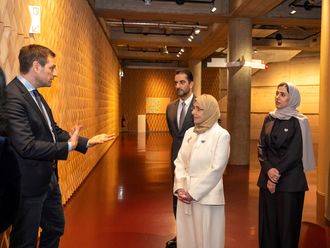The Abu Dhabi Islands Archaeological Survey (ADIAS) has reported the biggest fossil discovery in the region - a 2.54-metre elephant tusk dating back six to eight million years.
"We are stunned by this discovery, only a small part of the tusk was initially visible on the surface, though we suspected it might be an important find," said Dr. Mark Beech, Senior Resident Archaeologist of ADIAS.
"It is incredible that the tusk survived six to eight millions years. Other elephant remains have been found in the Western Region of Abu Dhabi, but this is much bigger and longer. It is also the first complete tusk found in the region," said an excited Dr Beech.
So far, 5,000 fossil fragments have been collected during the ADIAS work. Many are large enough and well-preserved for identification of the animals.
The tusk probably dates from the Late Miocene period, around six to eight million years ago when the Western Region of Abu Dhabi was a forested Savannah area with slow-moving rivers, like today's East Africa.
According to the archaeologists, the tusk may have belonged to a primitive form of elephant Stegotetrabelodon syrticus (Tassy, 1999), which was commonly found during the Late Miocene period in the Western Region of Abu Dhabi. However, further work is required to confirm its identification.
Late Miocene fossils have been found elsewhere in the Western Region by researchers from London's Natural History Museum and Yale University, but the tusk is the single largest fossil of this type and period ever found in the area that stretches from Pakistan to North Africa.
The tusk was discovered by an ADIAS team last October while surveying a project site for the Abu Dhabi Oil Refining Comp-any (Takreer) near Ruwais. "Survey for fossils in the Ruwais area of Abu Dhabi's Western Region has succeeded in finding the largest fossil elephant tusk ever found in the Middle East area," the ADIAS announced yesterday.
Work on the site, located near the junction of Ghiyathi road and Tarif-Sila'a highway, is being carried out by ADIAS with support from Takreer, the oil refinery arm of the Abu Dhabi National Oil Company. The area where the tusk was discovered is to be developed by Takreer for its new Central Environment Protection Facilities Project (BeAAT) in Ruwais.
In mid-November, Dr. Beech and other experts returned to the site. Dr. Beech, who has also discovered Miocene fossils in Kuwait and Pakistan, said: "Once we excavated the tusk, it was obvious that we needed to use some special techniques to lift it and take it to Abu Dhabi."
"The fossil was fragile and needed careful conservation at the site. We estimated that the tusk, along with a special case to protect it, would weigh up to 400 kg."
In early December, Dr. Beech and his team along with a scientist from Britain's University of York, Will Higgs, returned to the site.
The tusk was first treated with chemicals to prevent it from disintegrating, then it was covered with a special foam before being transported to Abu Dhabi. The logistic support was provided by Takreer.
The tusk is now awaiting further conservation treatment, following which it will be displayed by ADIAS and ERWDA.
Commenting on the discovery, a Takreer spokesman said: "We are delighted that our sponsorship of this work has yielded such magnificent results. After we settled on this area for our new Central Environment Protection Facilities Project, we commissioned an initial survey by the ADIAS last April to check for archaeological and fossil sites, as part of our continuing policy to protect the UAE's environment and heritage.
"Once the ADIAS informed us of the presence of important fossils in the area, we decided to go for further studies. This discovery is an important addition to our knowledge of the UAE's heritage, and Takreer is proud to have played a role in the excavation work."
Peter Hellyer, ADIAS Execu-tive Director, praised Takreer for supporting the excavation work. "Takreer has been enormously supportive of our work. Not only they commissioned us for a survey, they recognised the significance of our initial discoveries and agreed to give us further support to continue the studies. The results show the value of close collaboration between the oil industry and environmental and archaeological bodies like ERWDA and the ADIAS."
Besides the elephant tusk, a number of other important fossil discoveries have been made by ADIAS in the Ruwais area.
These include a probable hippopotamus skull, an elephant jaw, fragments of elephant teeth, crocodile jaws and teeth, leg bones of ancestors of the gazelle, and fragments of eggshells from ancestors of the ostrich.
In all, nearly 60 previously unrecorded fossil sites have been identified.
"This group of sites at Ruwais could very well prove to be one of the most important fossil localities," says Beech.
"Although some of the area will be developed, a large part of the site, covering several square kilometres, will now be protected, thanks to collaboration between Takreer, ADIAS and ERWDA."
Fossil tusk stuns experts
The Abu Dhabi Islands Archaeological Survey (ADIAS) has reported the biggest fossil discovery in the region - a 2.54-metre elephant tusk dating back six to eight million years.












